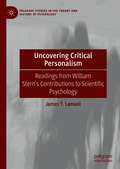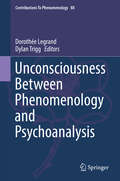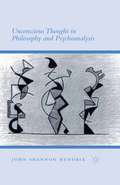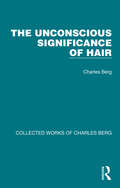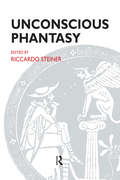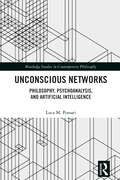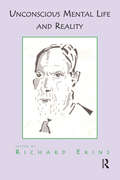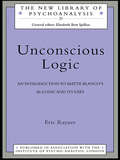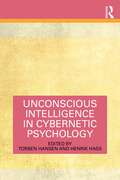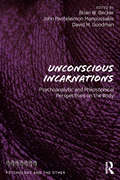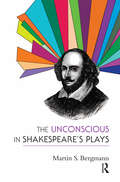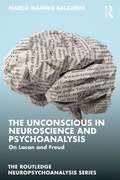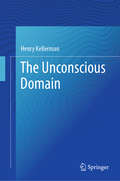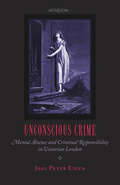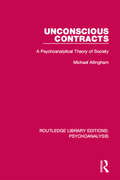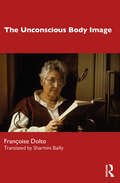- Table View
- List View
Uncovering Critical Personalism: Readings from William Stern’s Contributions to Scientific Psychology (Palgrave Studies in the Theory and History of Psychology)
by James T. LamiellThis book brings together the central tenets of William Stern’s critical personalism. Presented for the first time for an English-speaking audience, this selection of original translations and essays encapsulates the critical framework of Stern’s personalistic psychology. The selected works highlight the philosophical basis of Stern’s personalistic views, illustrate their relevance in domains of theoretical and practical importance in psychology, and reveal Stern’s critical stance on certain methodological trends that were gaining favor within psychology during his lifetime. Lamiell’s own chapters contextualise the translations by providing an overview of the most basic tenets of critical personalism, and offering a commentary on paradigmatic commitments within scientific psychology’s mainstream that began to impede Stern’s efforts prior to his death, and that remain obstacles to personalistic thinking in the discipline today. Largely ignored by his contemporaries, this work forms part of an emerging body of scholarship that seeks to reintroduce Stern’s thinking into contemporary psychology. The book is intended for academically oriented scholars with interests in historical, theoretical and philosophical issues in psychology.
Unconsciousness Between Phenomenology and Psychoanalysis (Contributions To Phenomenology #88)
by Dorothée Legrand Dylan TriggThis book contains a series of essays that explore the concept of unconsciousness as it is situated between phenomenology and psychoanalysis. A leading goal of the collection is to carve out phenomenological dimensions within psychoanalysis and, equally, to carve out psychoanalytical dimensions within phenomenology. The book examines the nature of unconsciousness and the role it plays in structuring our sense of self. It also looks at the extent to which the unconscious marks the body as it functions outside of experience as well as manifests itself in experience. In addition, the book explores the relationship between unconsciousness and language, particularly if unconsciousness exists prior to language or if the concept can only be understood through speech. The collection includes contributions from leading scholars, each of whom grounds their investigations in a nuanced mastery of the traditional voices of their fields. These contributors provide diverse viewpoints that challenge both the phenomenological and psychoanalytical traditions in their relation to unconsciousness.
Unconscious Thought in Philosophy and Psychoanalysis
by John Shannon HendrixThe book explores concepts throughout the history of philosophy that suggest the possibility of unconscious thought and lay the foundation for ideas of unconscious thought in modern philosophy and psychoanalysis. The focus is on the workings of unconscious thought and the role it plays in thinking, language, perception, and human identity.
The Unconscious Significance of Hair (Collected Works of Charles Berg)
by Charles BergOriginally published in 1951, the implications of this book were thought to be far wider and deeper than its title suggests. 'Hair-activities are chosen merely as a sample of uncritically accepted human behaviour. The author then proceeds to examine them very carefully in the light of dreams, anthropology, folklore, symptoms and perversions. He shows them to be an expression of instinct-driven tensions and conflicts. The popular illusion that they are determined by reason or adaption to reality is exploded. The corollary is inescapable; if in this innocent particular our thoughts and behaviour are symptomatic expressions of an unconscious conflict or complex, how much more psychopathic would our more significant ideas, beliefs, institutions, customs and laws prove to be on similar detailed investigation! Is, therefore, our self-expression in life and civilization nothing more than a symptom, identical in its source and mechanism with the symptoms of nervous and mental illness? The book is really a psychiatric criticism of normality based upon a chosen item of typically normal behaviour. It is, however, written in a way that will be easily understood by every intelligent reader.' This book is a re-issue originally published in 1951. The language used is a reflection of its era and no offence is meant by the Publishers to any reader by this re-publication.
The Unconscious Significance of Hair: A Sort Of Autobiography (Collected Works of Charles Berg)
by Charles BergOriginally published in 1951, the implications of this book were thought to be far wider and deeper than its title suggests. 'Hair-activities are chosen merely as a sample of uncritically accepted human behaviour. The author then proceeds to examine them very carefully in the light of dreams, anthropology, folklore, symptoms and perversions. He shows them to be an expression of instinct-driven tensions and conflicts. The popular illusion that they are determined by reason or adaption to reality is exploded. The corollary is inescapable; if in this innocent particular our thoughts and behaviour are symptomatic expressions of an unconscious conflict or complex, how much more psychopathic would our more significant ideas, beliefs, institutions, customs and laws prove to be on similar detailed investigation! Is, therefore, our self-expression in life and civilization nothing more than a symptom, identical in its source and mechanism with the symptoms of nervous and mental illness? The book is really a psychiatric criticism of normality based upon a chosen item of typically normal behaviour. It is, however, written in a way that will be easily understood by every intelligent reader.' This book is a re-issue originally published in 1951. The language used is a reflection of its era and no offence is meant by the Publishers to any reader by this re-publication.
Unconscious Phantasy
by Riccardo Steiner'There is no doubt that "phantasy" or "unconscious phantasy", as it started to be used in the English translation of Freud's work in the late 1920s and 1930s to differentiate it from "fantasy", is one of the most important theoretical and clinical concepts of psychoanalysis.'- Riccardo Steiner, from the IntroductionIn this outstanding new collection, the vital concept of unconscious phantasy is debated and examined by such luminaries as Joseph and Anne-Marie Sandler, Jean Laplanche, J-B Pontalis, Susan Isaacs and Hanna Segal. Sigmund Freud's seminal paper Formulations of the Two Principles of Mental Functioning heads an impressive collection and provides a welcome reminder of the beginnings of this theory. The inherent difficulties in translating Freud's work have contributed to the conflicting interpretations that are so illustrated so well in the following articles. By collecting together such diverse opinions of Freudians, Kleinians, Lacanians and Neuroscientists on unconscious phantasy, Riccardo Steiner has created a fresh and compelling elucidation of this fascinating subject.
Unconscious Phantasy (The\psychoanalytic Ideas Ser. #No. 6)
by Riccardo Steiner'There is no doubt that "phantasy" or "unconscious phantasy", as it started to be used in the English translation of Freud's work in the late 1920s and 1930s to differentiate it from "fantasy", is one of the most important theoretical and clinical concepts of psychoanalysis.'- Riccardo Steiner, from the IntroductionIn this outstanding new collection, the vital concept of unconscious phantasy is debated and examined by such luminaries as Joseph and Anne-Marie Sandler, Jean Laplanche, J-B Pontalis, Susan Isaacs and Hanna Segal. Sigmund Freud's seminal paper Formulations of the Two Principles of Mental Functioning heads an impressive collection and provides a welcome reminder of the beginnings of this theory. The inherent difficulties in translating Freud's work have contributed to the conflicting interpretations that are so illustrated so well in the following articles. By collecting together such diverse opinions of Freudians, Kleinians, Lacanians and Neuroscientists on unconscious phantasy, Riccardo Steiner has created a fresh and compelling elucidation of this fascinating subject.
Unconscious Networks: Philosophy, Psychoanalysis, and Artificial Intelligence (Routledge Studies in Contemporary Philosophy)
by Luca M. PossatiThis book develops an original theoretical framework for understanding human-technology relations. The author’s approach, which he calls technoanalysis, analyzes artificial intelligence based on Freudian psychoanalysis, biosemiotics, and Latour’s actor-network theory. How can we communicate with AI to determine shared values and objectives? And what, ultimately, do we want from machines? These are crucial questions in our world, where the influence of AI-based technologies is rapidly growing. Unconscious dynamics influence AI and digital technology and understanding them is essential to better controlling AI systems. This book’s unique methodology— which combines psychoanalysis, biosemiotics, and actor-network theory—reveals a radical reformulation of the problem of the human mind. Technoanalysis views the mind as a hybrid network of humans and nonhuman actants in constant interaction with one another. The author argues that human unconscious dynamics influence and shape technology, just as technology influences and shapes human unconscious dynamics. He proceeds to show how this conception of the relationship between the unconscious and technology can be applied to social robotics and AI. Unconscious Networks will appeal to scholars and advanced students interested in philosophy of technology, philosophy of artificial intelligence, psychoanalysis, and science and technology studies.
Unconscious Networks: Philosophy, Psychoanalysis, and Artificial Intelligence (Routledge Studies in Contemporary Philosophy)
by Luca M. PossatiThis book develops an original theoretical framework for understanding human-technology relations. The author’s approach, which he calls technoanalysis, analyzes artificial intelligence based on Freudian psychoanalysis, biosemiotics, and Latour’s actor-network theory. How can we communicate with AI to determine shared values and objectives? And what, ultimately, do we want from machines? These are crucial questions in our world, where the influence of AI-based technologies is rapidly growing. Unconscious dynamics influence AI and digital technology and understanding them is essential to better controlling AI systems. This book’s unique methodology— which combines psychoanalysis, biosemiotics, and actor-network theory—reveals a radical reformulation of the problem of the human mind. Technoanalysis views the mind as a hybrid network of humans and nonhuman actants in constant interaction with one another. The author argues that human unconscious dynamics influence and shape technology, just as technology influences and shapes human unconscious dynamics. He proceeds to show how this conception of the relationship between the unconscious and technology can be applied to social robotics and AI. Unconscious Networks will appeal to scholars and advanced students interested in philosophy of technology, philosophy of artificial intelligence, psychoanalysis, and science and technology studies.
Unconscious Mental Life and Reality
by Richard EkinsIt shows the present collection of seminal essays to offer a balanced yet rigorous examination of the durability and contemporary relevance of psychoanalysis, understood as a comprehensive system of theory and technique. The contributors eschew the establishment of yet another school of Freudian thought, not wishing to add to the already confusing array of competing and conflicting perspectives. Each essay seeks to underscore, refine and add to the perceived strength, richness and flexibility of early psychoanalytic thought. A broad range of psychoanalytic concerns are addressed: the unconscious, mind and brain, mind and body, affect, cognition and character. Each topic is surveyed in a spirit of thoughtful and judicious consolidation. Open, and well-informed, a sure course is taken between the opposing dangers of dogma and fragmentation. Insisting upon a well-grounded appreciation of the origins and historical unfolding of psychoanalysis, and remaining close to both clinical observations and theoretical developments, the present volume looks forward to the continuing fertility and pertinence of psychoanalytical exploration.
Unconscious Logic: An Introduction to Matte Blanco's Bi-Logic and Its Uses (The New Library of Psychoanalysis #Vol. 21)
by Eric RaynerWhile the theories of Matte Blanco about the structure of the unconscious and the way in which it operates are generally recognised to be the most original since those of Freud, for many people the ways in which his ideas are expressed, including the use of terminology from mathematics and logic, make them difficult of access. Eric Rayner has written the first clear introduction to Matte Blanco's key concepts for psychotherapists and psychoanalysts and all those concerned with moving psychoanalytic thinking forward. He sets out the central ideas in a way which is easy to understand and then shows, with examples, how they relate to clinical practice. He also describes how the ideas are related to those of people in other disciplines - mathematics, logic, psychology (specifically Piaget), and anthropology, among others. Drawing on the work of a group of people who have been inspired by Matte Blanco's thinking to extend their own ideas and test them out in the consulting room, this book reveals the significance of Matte Blanco's thought for future research.
Unconscious Logic: An Introduction to Matte Blanco's Bi-Logic and Its Uses (The New Library of Psychoanalysis)
by Eric RaynerWhile the theories of Matte Blanco about the structure of the unconscious and the way in which it operates are generally recognised to be the most original since those of Freud, for many people the ways in which his ideas are expressed, including the use of terminology from mathematics and logic, make them difficult of access. Eric Rayner has written the first clear introduction to Matte Blanco's key concepts for psychotherapists and psychoanalysts and all those concerned with moving psychoanalytic thinking forward. He sets out the central ideas in a way which is easy to understand and then shows, with examples, how they relate to clinical practice. He also describes how the ideas are related to those of people in other disciplines - mathematics, logic, psychology (specifically Piaget), and anthropology, among others. Drawing on the work of a group of people who have been inspired by Matte Blanco's thinking to extend their own ideas and test them out in the consulting room, this book reveals the significance of Matte Blanco's thought for future research.
Unconscious Intelligence in Cybernetic Psychology
by Torben HansenThis important book examines how the growing field of cybernetic psychology - the study of the creative complexity of the mind - can be applied to a range of different realms, tapping into the unconscious potential within us all. Cybernetic psychology integrates theories from various schools of thought, bringing them together in one unified theory. First developed and described by Danish author and psychotherapist Ole Vedfelt. It can be used in therapeutic practice, in relation to learning and pedagogics, and as a tool for better leadership. The 15 chapters within this volume apply the theory to these as well as other areas, including ecology, creativity, mindfulness and scientific enquiry itself. Insightful and wide-ranging, the book will appeal to psychotherapists and those working within mental health, as well as students and researchers across Education, Psychology and beyond.
Unconscious Intelligence in Cybernetic Psychology
This important book examines how the growing field of cybernetic psychology - the study of the creative complexity of the mind - can be applied to a range of different realms, tapping into the unconscious potential within us all. Cybernetic psychology integrates theories from various schools of thought, bringing them together in one unified theory. First developed and described by Danish author and psychotherapist Ole Vedfelt. It can be used in therapeutic practice, in relation to learning and pedagogics, and as a tool for better leadership. The 15 chapters within this volume apply the theory to these as well as other areas, including ecology, creativity, mindfulness and scientific enquiry itself. Insightful and wide-ranging, the book will appeal to psychotherapists and those working within mental health, as well as students and researchers across Education, Psychology and beyond.
Unconscious Incarnations: Psychoanalytic and Philosophical Perspectives on the Body (Psychology and the Other)
by John Panteleimon Manoussakis Brian W. Becker David M. GoodmanUnconscious Incarnations considers the status of the body in psychoanalytic theory and practice, bringing Freud and Lacan into conversation with continental philosophy to explore the heterogeneity of embodied life. By doing so, the body is no longer merely an object of scientific inquiry but also a lived body, a source of excessive intuition and affectivity, and a raw animality distinct from mere materiality. The contributors to this volume consist of philosophers, psychoanalytic scholars, and practitioners whose interdisciplinary explorations reformulate traditional psychoanalytic concepts such as trauma, healing, desire, subjectivity, and the unconscious. Collectively, they build toward the conclusion that phenomenologies of embodiment move psychoanalytic theory and practice away from representationalist models and toward an incarnational approach to psychic life. Under such a carnal horizon, trauma manifests as wounds and scars, therapy as touch, subjectivity as bodily boundedness, and the unconscious ‘real’ as an excessive remainder of flesh. Unconscious incarnations signal events where the unsignifiable appears among signifiers, the invisible within the visible, and absence within presence. In sum: where the flesh becomes word and the word retains its flesh. Unconscious Incarnations seeks to evoke this incarnational approach in order to break through tacit taboos toward the body in psychology and psychoanalysis. This interdisciplinary work will appeal greatly to psychoanalysts and psychoanalytic psychotherapists as well as philosophy scholars and clinical psychologists.
Unconscious Incarnations: Psychoanalytic and Philosophical Perspectives on the Body (Psychology and the Other)
by John Panteleimon Manoussakis Brian W. Becker David M. GoodmanUnconscious Incarnations considers the status of the body in psychoanalytic theory and practice, bringing Freud and Lacan into conversation with continental philosophy to explore the heterogeneity of embodied life. By doing so, the body is no longer merely an object of scientific inquiry but also a lived body, a source of excessive intuition and affectivity, and a raw animality distinct from mere materiality. The contributors to this volume consist of philosophers, psychoanalytic scholars, and practitioners whose interdisciplinary explorations reformulate traditional psychoanalytic concepts such as trauma, healing, desire, subjectivity, and the unconscious. Collectively, they build toward the conclusion that phenomenologies of embodiment move psychoanalytic theory and practice away from representationalist models and toward an incarnational approach to psychic life. Under such a carnal horizon, trauma manifests as wounds and scars, therapy as touch, subjectivity as bodily boundedness, and the unconscious ‘real’ as an excessive remainder of flesh. Unconscious incarnations signal events where the unsignifiable appears among signifiers, the invisible within the visible, and absence within presence. In sum: where the flesh becomes word and the word retains its flesh. Unconscious Incarnations seeks to evoke this incarnational approach in order to break through tacit taboos toward the body in psychology and psychoanalysis. This interdisciplinary work will appeal greatly to psychoanalysts and psychoanalytic psychotherapists as well as philosophy scholars and clinical psychologists.
The Unconscious in Shakespeare's Plays
by Martin S. BergmannJust as concerts emerge from the interaction of many instruments, so our understanding of Shakespeare is enriched by different approaches to him. Psychoanalysis assumes that creative writers have the need to both reveal and conceal their own inner conflicts in their works. They leave residues in their works that, if we pay attention, can become building blocks that reveal aspects of the unconscious. Readers may find that the questions raised add to the pleasure of reading Shakespeare and that they deepens their understanding of his plays. Topics covered include the pivotal position of Hamlet, the poet and his calling, the Oedipus complex, intrapsychic conflict, the battle against paranoia and the homosexual compromise. By using psychoanalytic techniques in analyzing his plays and characters, the author reveals more about Shakespeare's hidden motivations and mental health.
The Unconscious in Shakespeare's Plays
by Martin S. BergmannJust as concerts emerge from the interaction of many instruments, so our understanding of Shakespeare is enriched by different approaches to him. Psychoanalysis assumes that creative writers have the need to both reveal and conceal their own inner conflicts in their works. They leave residues in their works that, if we pay attention, can become building blocks that reveal aspects of the unconscious. Readers may find that the questions raised add to the pleasure of reading Shakespeare and that they deepens their understanding of his plays. Topics covered include the pivotal position of Hamlet, the poet and his calling, the Oedipus complex, intrapsychic conflict, the battle against paranoia and the homosexual compromise. By using psychoanalytic techniques in analyzing his plays and characters, the author reveals more about Shakespeare's hidden motivations and mental health.
The Unconscious in Neuroscience and Psychoanalysis: On Lacan and Freud (The Routledge Neuropsychoanalysis Series)
by Marco Máximo BalzariniThe Unconscious in Neuroscience and Psychoanalysis presents a unique and provocative approach to the assimilation of these two disciplines while offering a thorough assessment of the unconscious from a neuropsychoanalytic and Lacanian perspective.Marco Máximo Balzarini offers a comprehensive overview of Freud’s theory of the unconscious and its importance within psychoanalysis, before looking to how it has been integrated into contemporary neuropsychoanalytic work. Paying close attention to the field-defining work of neuropsychoanalysts such as Mark Solms, Francois Ansermet, and Pierre Magistretti, Balzarini considers the dichotomy between neuroscience and psychoanalysis, and the omnipresent debate on if and how they should be integrated when working with the unconscious. Throughout, he provides a fascinating Lacanian interpretation, showing how the work of Lacan can offer a new way of developing the dialogue and understanding around this vital topic.Part of the Routledge Neuropsychoanalysis Series, this book will be of interest to any psychoanalyst seeking to explore the foundations of the relationship between neuropsychoanalytic and Lacanian ideas in their clinical and theoretical work.
The Unconscious in Neuroscience and Psychoanalysis: On Lacan and Freud (The Routledge Neuropsychoanalysis Series)
by Marco Máximo BalzariniThe Unconscious in Neuroscience and Psychoanalysis presents a unique and provocative approach to the assimilation of these two disciplines while offering a thorough assessment of the unconscious from a neuropsychoanalytic and Lacanian perspective.Marco Máximo Balzarini offers a comprehensive overview of Freud’s theory of the unconscious and its importance within psychoanalysis, before looking to how it has been integrated into contemporary neuropsychoanalytic work. Paying close attention to the field-defining work of neuropsychoanalysts such as Mark Solms, Francois Ansermet, and Pierre Magistretti, Balzarini considers the dichotomy between neuroscience and psychoanalysis, and the omnipresent debate on if and how they should be integrated when working with the unconscious. Throughout, he provides a fascinating Lacanian interpretation, showing how the work of Lacan can offer a new way of developing the dialogue and understanding around this vital topic.Part of the Routledge Neuropsychoanalysis Series, this book will be of interest to any psychoanalyst seeking to explore the foundations of the relationship between neuropsychoanalytic and Lacanian ideas in their clinical and theoretical work.
The Unconscious Domain (Springerbriefs In Psychology Ser.)
by Henry KellermanThis book enumerates the components of the unconscious domain (or realm), and attempts to uncover the proposed communicational network of its operation — a communicational network that is able to link inherent participating components of this realm. It is often the case that theoreticians and clinical practitioners refer to the unconscious or unconscious material in a way that implies the sense of it all rather than a specific definition, broadly describing it as “material which is out of one’s awareness.” This volume therefore examines the complex existence of the entire unconscious realm embraced in an evolutionary historical context, defined here as the 'unconscious domain'.
Unconscious Crime: Mental Absence and Criminal Responsibility in Victorian London
by Joel Peter EigenA sleepwalking, homicidal nursemaid; a "morally vacant" juvenile poisoner; a man driven to arson by a "lesion of the will"; an articulate and poised man on trial for assault who, while conducting his own defense, undergoes a profound personality change and becomes a wild and delusional "alter." These people are not characters from a mystery novelist's vivid imagination, but rather defendants who were tried at the Old Bailey, London's central criminal court, in the mid-nineteenth century. In Unconscious Crime, Joel Peter Eigen explores these and other cases in which defendants did not conform to any of the Victorian legal system's existing definitions of insanity yet displayed convincing evidence of mental aberration. Instead, they were—or claimed to be—"missing," "absent," or "unconscious": lucid, though unaware of their actions.Based on extensive research in the Old Bailey Sessions Papers (verbatim courtroom narratives taken down in shorthand during the trial and sold on the street the following day), Eigen's book reveals a growing estrangement between law and medicine over the legal concept of the Person as a rational and purposeful actor with a clear understanding of consequences. The McNaughtan Rules of l843 had formalized the Victorian insanity plea, guiding the courts in cases of alleged delusion and derangement. But as Eigen makes clear in the cases he discovered, even though defense attorneys attempted to broaden the definition of insanity to include mental absence, the courts and physicians who testified as experts were wary of these novel challenges to the idea of human agency and responsibility. Combining the colorful intrigue of courtroom drama and the keen insights of social history, Unconscious Crime depicts Victorian England's legal and medical cultures confronting a new understanding of human behavior, and provocatively suggests these trials represent the earliest incarnation of double consciousness and multiple personality disorder.
Unconscious Contracts: A Psychoanalytical Theory of Society (Routledge Library Editions: Psychoanalysis)
by Michael AllinghamOriginally published in 1987 this highly original work explores how the nature and institutions of society are determined by our unconscious as well as our conscious aims – how individuals join together in ‘unconscious contracts’. The author does this by integrating psychoanalysis and social science to generate a psychoanalytical theory of society. The key to this theory is the interpretation of both psychoanalysis and social science in terms of the interplay between conflict and co-operation. Professor Allingham starts by discussing the workings of the individual mind, and tracing the development of the adult personality from its roots in infancy. He uses this background to show how the group acts as a key link between the individual and society, and the sense in which groups have lives of their own. He completes the theory by demonstrating how the unconscious aims of the members of society are translated, through the various groups to which they belong, into the institutions adopted by society. Finally, as an extension, he explores the nature of the unconscious motives which underlie our conscious social and political attitudes.
Unconscious Contracts: A Psychoanalytical Theory of Society (Routledge Library Editions: Psychoanalysis #1)
by Michael AllinghamOriginally published in 1987 this highly original work explores how the nature and institutions of society are determined by our unconscious as well as our conscious aims – how individuals join together in ‘unconscious contracts’. The author does this by integrating psychoanalysis and social science to generate a psychoanalytical theory of society. The key to this theory is the interpretation of both psychoanalysis and social science in terms of the interplay between conflict and co-operation. Professor Allingham starts by discussing the workings of the individual mind, and tracing the development of the adult personality from its roots in infancy. He uses this background to show how the group acts as a key link between the individual and society, and the sense in which groups have lives of their own. He completes the theory by demonstrating how the unconscious aims of the members of society are translated, through the various groups to which they belong, into the institutions adopted by society. Finally, as an extension, he explores the nature of the unconscious motives which underlie our conscious social and political attitudes.
The Unconscious Body Image
by Françoise DoltoThe Unconscious Body Image espouses a completely original view of the links between physical and psychic development, providing fresh insight into our understanding of psychosomatic symptoms and child development. Françoise Dolto describes how unconsciously held mental images of the body and its functioning impact upon the subject’s feelings and ideas of themself, and conversely how emotions and ideas impact upon the body’s functioning by way of these unconscious images. The Unconscious Body Image also presents Dolto’s view of the development of mind in relation to unconscious body images generated at each stage of development (oral, anal, genital, latency and puberty), and ideas about psychic castration at each developmental stage and children’s socialisation, filling a significant gap in psychoanalytic understanding of the mental integration of social law. This book will be a key text for psychoanalysts in practice and in training, particularly those working with children, psychoanalytic psychotherapists and psychodynamic practitioners in the social sciences, childcare and education.
